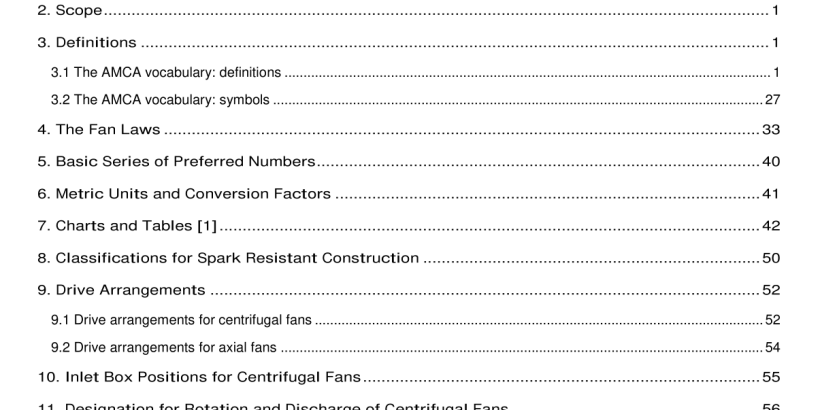ANSI AMCA 99-16 pdf download.Standards Handbook
4. The Fan Laws
Fan impellers differ from one another in many respects, even among those of the same type. One characteristic that all share is that each individual impeller design can be uniquely related to the overall diameter of the impeller (see Annex A of AMCA Publication 21 1 ). Because of this unique relationship, all impellers that share the same geometric design but differ only in size are said to have similarity. Fan casings share in this unique relationship, with the casing being optimized with respect to an impeller design so that aerodynamic performance goals are achieved. A fan design, then, is a geometrically unique combination of fan impeller and fan casing. All sizes of fans produced according to this unique geometry have similarity based on their respective diameters. Similarity is useful in that it enables the prediction of aerodynamic performance: given the performance of a fan of a given diameter at a certain rotational speed and a certain air density, the performance of that same unique geometry at another impeller diameter or rotational speed or air density can be determined. Note that the variables that affect a fan’s aerodynamic performance are impeller diameter, rotational speed and air density. Since these variables are expressed as ratios, they are dimensionless and independent of the system of units used, as long as the units are used consistently for each ratio. The mathematical statements that describe the effects of these factors on aerodynamic performance for any known performance point are known collectively as the fan laws.
Fan laws for compressible flow As with all laws, some similarity requirements must be met if the fan laws are to be effective: Design geometry Geometric similarity must exist between any two fan sizes; i.e., dimensions must be proportional and angularity must be constant for all essential air passages of the impeller and the casing. Gas density As air moves through the fan, it is acted upon by the rotating impeller and there results a pressure rise. With a pressure rise, one would expect that the gas undergoes compression. Compression, in turn, means a change in gas density. The compressibility coefficient, K p , must be calculated for the condition. The supporting formulas for K p originate in ANSI/AMCA Standard 21 0. Reynolds number Reynolds number is one of many descriptors of fan performance, and further information is available in most textbooks on fluid mechanics. For our purposes here, it is necessary to know that for a given fan design geometry, there are many possible Reynolds numbers, and there is a threshold value on either side of which fluids behave differently. The similarity requirement here is that both sets of operating parameters result in Reynolds numbers such that the effect of any difference between them is negligible. The implied requirement is that both of the Reynolds numbers must be on the same side of the threshold value. For additional information on Reynolds number, see the Handbook of Fan Engineering, latest edition.
Mach number Mach number relates to the velocity of a gas (air) as it passes into or through a fan. Similarity requires that the Mach numbers for the two sets of parameters must be reasonably close. Just as was the case with Reynolds number, there is a threshold value and a difference in performance on either side of the threshold. Since almost all fans operate well below the threshold value for Mach number, no procedure for determining the threshold value is given in this document. Then for any given point on a fan performance curve, the relationship between a known performance point and desired performance point, c (converted), is given by the fan laws.ANSI AMCA 99-16 pdf download
